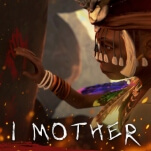Massive Chalice: Family Matters

Massive Chalice, at is finest, feels like an indrawn breath, a nervous stillness punctured by the monstrous sounds of the Cadence lingering at the edge of the battlefield. As you scout ahead with your cloaked Hunters, you reach that point where your breath starts to hold, and as you lunge in with a phalanx of Caberjacks and Alchemists, giant logs and explosive flasks become the deafening shout punctuating your successful short-term strategy. It’s boisterously thrilling—even if sometimes, it’s a thrill to be felt over and over again.
That indrawn breath also follows you into the metagame—as Double Fine’s Kickstarter-backed strategy game moves out of the battlefield, you assume your spot on the throne of a kingdom bound on a 300-year journey for salvation. Your heroes, whether they be on standby for battle, or assigned to keeps to raise families, become part of a large tapestry of time where small decisions guide your efforts for “years” of in-game time. Those years translate to a matter of hours, and one campaign can prove to be as long as 18 hours of play.
Massive Chalice promotes a kind of mentality for “the greater good,” or maybe just “the longest view,” where heroes enter arranged marriages and willingly submit themselves to your matchmaking in order to raise generations of worthy soldiers. It brings you to that state in small moments, like assigning relics from parent to child, or using the tanky Caberjack characters to save the life of your elderly Sagewrights on a rescue mission.
The game’s combat finds sufficient complexity in that matchmaking system. There are only three base class units—Caberjack, Alchemist, Hunter—but assigning these heroes into relationships allows the creation of hybrid classes that blend them together and can create unique team compositions that can get you out of sticky situations. A particular favorite is the Shadowjack—a child of Hunters and Caberjacks who has the hunter’s stealth but the Caberjack’s brute force. A team of Shadowjacks, Hunters and Trickshots can move through the battlefield like ghosts and collapse on Cadence forces. Enemies also benefit from a surprising number of counterplay-focused tactics—Bulwarks break the stereotype of “ranged glass cannons,” and will armor up if you don’t land a killing blow, while ranged Lapses and melee-focused Wrinklers will sap your hero’s experience points or prematurely age them if allowed to wail on your forces.
The characters are also refreshingly diverse in other ways too. Your heroes come from a wide pool of ethnicities, and the game even supports an adoption system that allows for successful lines built on same-sex marriages. Such arrangements do come with a trade-off of research time that might be expended on other necessary projects, so heterosexual couples are still encouraged by the basic design. This part of the system may teeter on if players preferring to match same-sex relationships feel disadvantaged by needing to constantly run adoption loops instead of researching equipment.
The formula all fits the tone, which is that Celtic fantasy heroism described before. Even in only three to four mission types, (and two of them are not common occurrences), battle remains regularly compelling, especially when your squad is mixed up as frequently as it can be by the passing of years and heroes. Unlike Chalice’s turn-based cousins Fire Emblem or XCOM: Enemy Unknown, heroes dying on the battlefield doesn’t dramatically interfere with your long-term strategy, and so long as proper matchmaking is taking place, the next generation of heroes will likely be ready to replace your fallen ones even after dire conflicts.
Massive Chalice’s core design definitely strikes true for the bulk of the project, but it’s made by a smaller team at the mid-sized Double Fine studio, and its shortcomings reflect the design team’s limited size and budget. For instance, as mentioned before, there’s only a handful of mission types, and the most common of them is simply “clear the map of all enemies.” In the compressed playtime for this review, these missions could become repetitive, especially in the gaps where a bloodline’s heroes are at maximum potential power but the enemy classes haven’t begun to sufficiently advance in power or quantity.
-

-

-

-

-

-

-

-

-

-

-

-

-

-

-

-

-

-

-

-

-

-

-

-

-

-

-

-

-

-

-

-

-

-

-

-

-

-

-

-










































